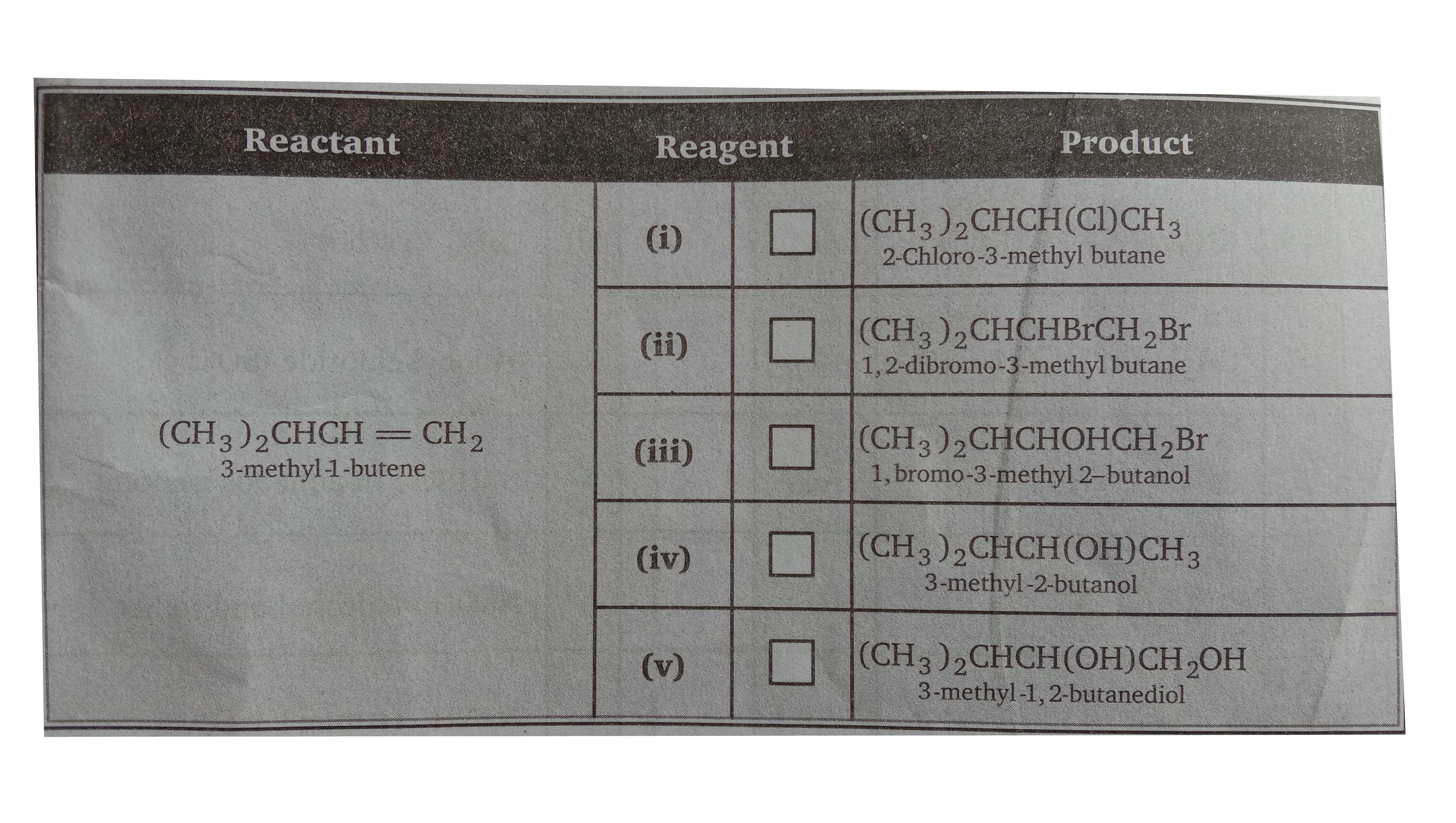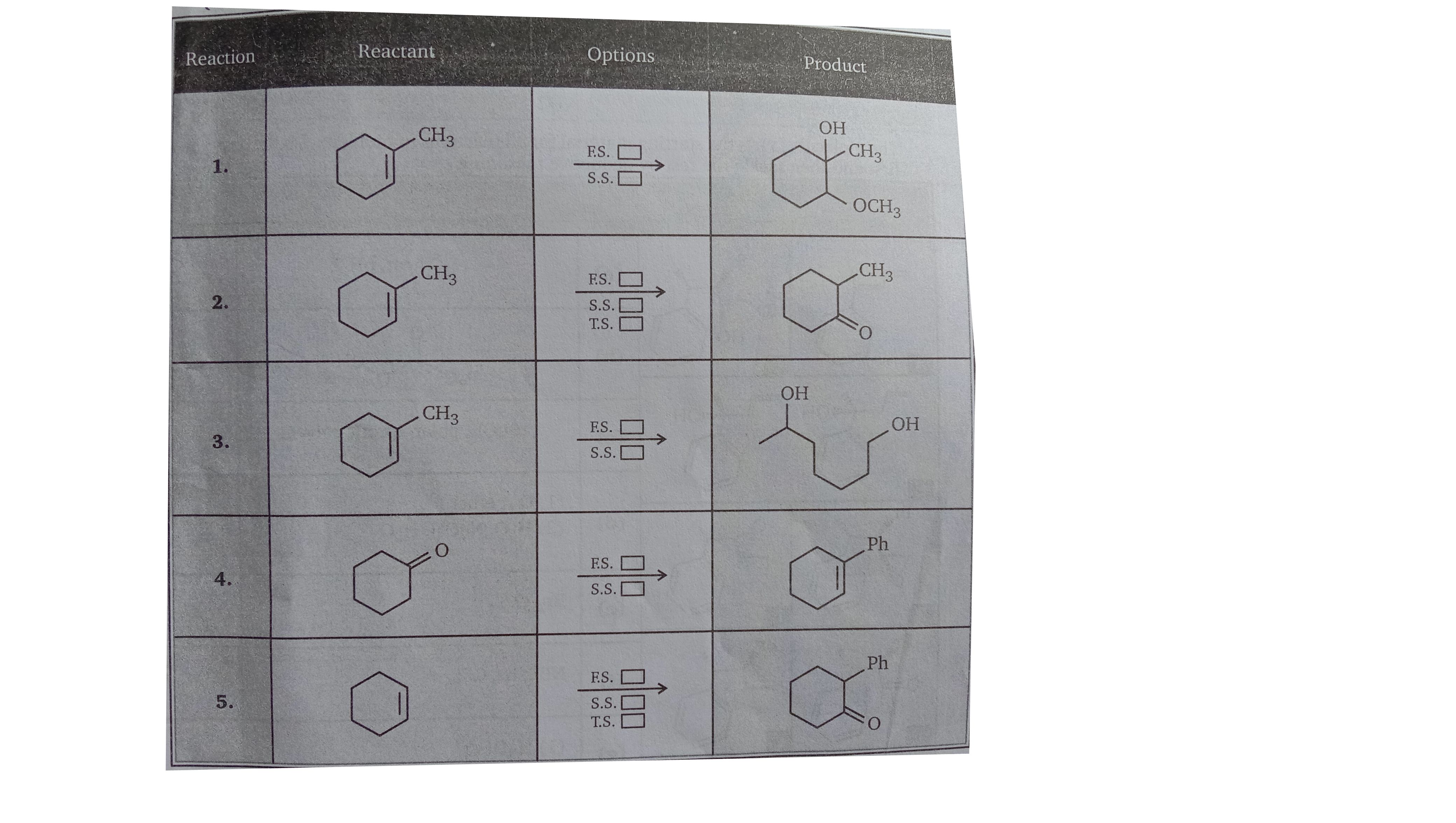Isobutyl alcohol (2-methyl-1-propanol) , can be transformed to each of the compounds (a through 1) listed in the left-hand column. In each case the number of steps needed to accomplish the change is noted, and an answer box is provided for your reagent Write letters designating the reagent or reagents you believe will achieve the desired transformation in the box to the right of the product formula. In the case of a multi-step sequence write the reagents in the order they are to be used. In some cases you maywish to use a previously prepared compound as a reactant. If so, write the number (a to 1) corresponding to the desired compound.
 Solution in Telugu
Solution in Telugu
The correct Answer is:a - B; b - I; c - F; d - G; e - I, H or 2 H; f - B, E or 1, E; g - J; h - G, Nor 4N i - N, j - I, A, C or 2AC or ILD or 2LD; k - B, K, D or 1KD; 1-B, E, D or lED or 6D
Basic information of organic reaction.
Topper's Solved these Questions
- 5C ALKYL HALIDES BOOK - MS CHOUHANCHAPTER - 5C ALKYL HALIDES EXERCISE - LEVEL-2 (SUBJECTIVE PROBLEMS)
1 Videos
- 5C ALKYL HALIDES BOOK - MS CHOUHANCHAPTER - 5C ALKYL HALIDES EXERCISE - LEVEL-2 (SUBJECTIVE PROBLEMS)
1 Videos
- ALCOHOL,ETHERS AND EPOXIDESBOOK - MS CHOUHANCHAPTER - ALCOHOL,ETHERS AND EPOXIDESEXERCISE - SUBJECTIVE PROBLEMS
1 Videos
Similar Questions

X = Total number of substitution and elimination product(s). Find the value of X.
View Solution
X = Total number of substitution and elimination product(s). Find the value of X.
View Solution
Maximum number of moles of Ac2O consumed by reactant (A) is :
View Solution In each reagent box write a letter designating the best reagent and condition selected from the above list of reagents.
In each reagent box write a letter designating the best reagent and condition selected from the above list of reagents.

View SolutionPropene (CH_(3)-CH=CH_(2)) can be transformed to compounds (a to j) listed in the left-hand column. Write letter designating the reagent, you believe desired transformation. In the case of multi-step sequence write the reagent in the order they are to be used.
View SolutionIn each reaction box write a single letter designating the best reagent and condition selected from the list at bottom of the page.


View SolutionIsobuty alcohol (2 -mehyl 1 -1-propanol), (CH_(3))_(2)CHCH_(2)OH, can be transformed to each of the compounds (a through 1) listed in the left-hand column. In each case the number of steps the needed to accomplish the change is noted, and an answer box is noted, and answer box is provided for your reagent selections. Fourteen reagents (designated A through N) are listen in the right -hand column. corresponding to the desired compound. Write letters desiganating the raagent or reagents you believe will achieve the desired transformation in the box to the right of the product formula. In the case of a multi-step sequence write the reagents in the order they are to be used. In some cases you may wish to use a previously prepared compound as a reactant. If so, write the number (a to 1) corresponding to the desired compound.
View SolutionThe dihydric alcohol , CH3−CH(OH)2 gives rise to the following compound , without acted upon by an reagent
View Solutionप्रोपीन, CH3−CH=CH2 ऑक्सीकरण द्वारा 1-प्रोपेनॉल में परिवर्तित हो जाती है। इस परिवर्तन पर प्रभाव डालने के लिये अभिकर्मकों का कौनसा युग्म सर्वाधिक उपयुक्त है
View SolutionIdentify the reagents necessary to achieve each of the following transformation.
View SolutionIdentify the reagents necessary to achieve each of the following transformation.

View SolutionIdentify the reagents necessary to achieve each of the following transformation.

View SolutionWrite the best reagents above each reaction arrow. If the transformation cannot be achieved in a single step by any reagents, write "NR"

View SolutionWrite the best reagents above each reaction arrow. If the transformation cannot be achieved in a single step by any reagents, write "NR"
View SolutionWrite the best reagents above each reaction arrow. If the transformation cannot be achieved in a single step by any reagents, write "NR"
View SolutionSelect the best reagent (s) to accomplish the following transformation

View Solution
